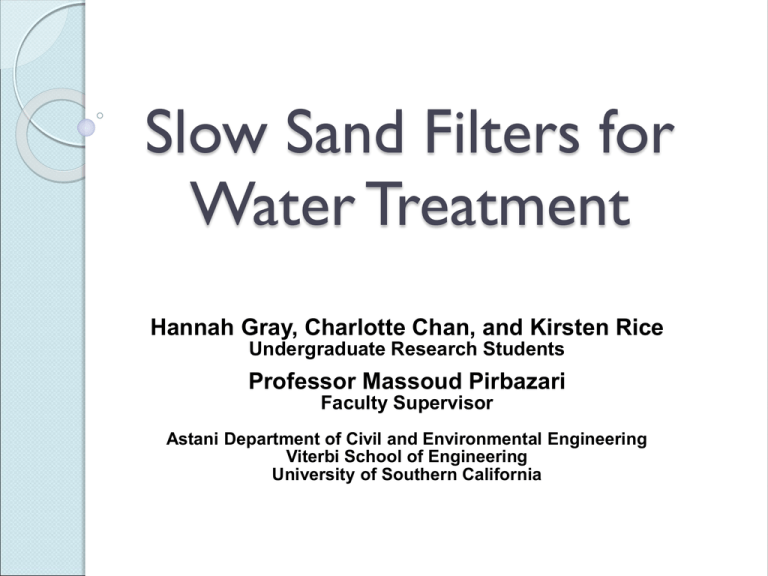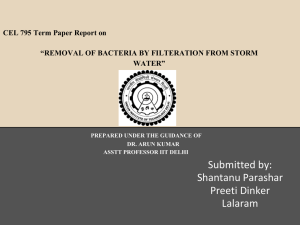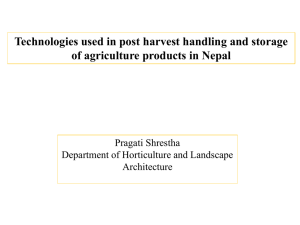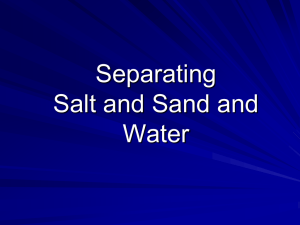Slow Sand Filters for Water Treatment
advertisement

Slow Sand Filters for Water Treatment Hannah Gray, Charlotte Chan, and Kirsten Rice Undergraduate Research Students Professor Massoud Pirbazari Faculty Supervisor Astani Department of Civil and Environmental Engineering Viterbi School of Engineering University of Southern California S.W.A.N. is an initiative started by Professor Massoud Pirbazari of the University of Southern California focusing on the improvement of drinking water quality for citizens of developing countries. SWAN's goal is to provide comprehensive and visually based information so that people, at the household level, can treat their water, and in turn, improve their health and well-being. THIS SITE IS UNDER CONSTRUCTION. All material included in this presentation have been adapted from sources* outlined on the final slide. * We would like to thank those whose work has been pivotal in the creation of this site. (See Reference Page for Sources) To the Visitor, Your comments and suggestions would be appreciated. Please direct your thoughts to Hannah Gray, Charlotte Chan or Kirsten Rice at hannahgr@usc.edu, szeyanch@usc.edu, kirstenr@usc.edu. Thank you. World Water Crisis: An Introduction • One in five people do not have access to safe drinking water • Every 15 seconds a child dies from water related diseases • Some young children and women trek up to six miles a day in order to collect water for their families Women carrying water drums Water Related Diseases and Their Causes Diseases • • • • • • • • • • • Bacteria • Diarrhea • Arsenicosis • Fluorosis Schistosomiasis • Intestinal Worms Guinea Worm Hepatitis Cholera Malaria Trachoma Typhoid E. coli Salmonella typhi Shigella spp. Yersinia enterocolitica E. coli bacteria Viruses • • • • Hepatitis A/E virus Adenovirus Enterovirus Rotavirus Hepatitis A Virus A Cure for this Global Problem? Problems with High-Tech Treatment Systems for Rural Areas of Developing Countries • • • Usually are expensive and difficult to construct Require expensive mechanical equipment Require expensive and dangerous chemicals (e.g. chlorine) High-Tech treatment system Options for Home Water Treatment • Ceramic Filters: filter water through pours in ceramic pots, candles, disks. Ceramic filter • Solar Disinfection: disinfection occurs by pasteurization when left in the sun for over six hours. • Boiling Water: Solar disinfection microbes disinfect through heat. Boiling water Options for Home Water Treatment (cont’d) • Flocculant: chemicals cause the precipitation of minerals so that they clump together and remove bacteria Flocculant disinfectant • Bio-Sand Filter: sand and a biological layer trap and feeds off of microorganisms and contaminants, usually for household use Bio-sand filter The Slow Sand Filter: Water Treatment for Small Rural Communities What is slow sand filtration? • Large scale community water treatment system • Water filters through a layer of sand with gravel base • Gravity is the driving force • Collective pipes • No chemicals added • Small pore space traps and removes particles • Formation of biofilm above the sand contributes to the reduction of bacteria, Slow sand filter viruses, protozoa and colloidal particles Advantages of the Slow Sand Filter • Long design life • Can use local materials and labor • Inexpensive and easy to construct • Minimal sludge handling problems • Close operator supervision is not necessary • Filters enough water for a Family and Volunteers with a community slow sand filter (up to 15,000 gal/day) • Viable for the 21st century • Reduces bacteria, cloudiness, and organic levels • Minimal power and chemical requirements History of the Slow Sand Filter • Slow Sand Filter dates back to 1790 in Lancashire, England • Spread throughout Europe and United States by the mid and late 1800’s • By 1940, the United States had around 100 slow sand filters purifying a total of 52.6 million gallons a day • According to the World Health Organization, "Under suitable circumstances, slow sand filtration may be not only the cheapest and simplest but also the most efficient method of water treatment." What will make the filter suitable for rural communities? • Simple filtration technology • Low construction and operation cost • Excellent removal of pathogenic organisms • Good removal of turbidity • Low energy consumption • Minimal sludge handling • Does not need constant operator attention Typical Slow Sand Filter Schematic Filter Body Placement • Often built below ground level • If above ground, ramps or ladders are built for access Beds • • • Larger beds can span up to 0.3 acres in size Constructed out of concrete Precast beds are available Tanks • • • Hold between 205-100,000 liters of water Optimum flow rate: 100 l/hr per m2 of surface area Multiple tanks may replace one large tank to ensure available Large scale slow sand filter water during cleaning Drainage System Purpose • • Collect draining water Ensure outflow water is free of gravel and sand debris Possible Materials • • • • • Bricks Concrete slabs Porous concrete Perforated pipes Screen system Pipes for the Drainage System Supernatant Water: Layer on top of Schmutzdecke Purpose • Extra force to push water through filter Criteria • Depth no less than 1.5 m Concern • • May freeze in cold climate Covered filter could be used, but is often most costly and need to supply room for operators Supernatant water is the water column above the sand Biological Layer: The Schmutzdecke • Due to the organic and biological matter in the water to be filtered, a bio-layer grows on top of the sand layer • The bio-layer contributes to water treatment by consuming organic contaminants including bacteria and viruses • A four week period of saturation before drinking is suggested so the layer fully develops • The majority of biological activity occurs in the top 20 cm of the filter Biofilm Development Layer of Schmutzdecke Filter Media- Fine Sand Filter Bed Criteria for top layer of filter media • Size of particles: ~0.15-0.35 mm • Particles must be uniform • Free of organic matter, loam, and clay Different sized sand particles • Depth greater than 0.6 m (every 0.3 meters of extra sand will help the filter media to last an extra 3-4 years) Filter Media – Gravel Layer Construction: Separate into 3 grades • Top • Finest • 2-8 mm • Middle • Size 8-16 mm • Bottom • Coarsest • Size 16-32 mm Purpose • • Supports the sand Contributes to uniform filtration Coarse gravel Design Summary Design parameters Recommended range of values Filtration rate Area per filter bed 0.15 m3/m2•h (0.1–0.2 m3/m2•h) Less than 200 m2 (in small community water supplies to ease manual filter cleaning) Number of filter beds Minimum of two beds Depth of filter bed 1 m (minmum of 0.7 m of sand depth) Filter media Effective size (ES) = 0.15–0.35 mm; uniformity coefficient (UC) = 2-3 Height of supernatant water 0.7–1 m (maximum 1.5 m) Underdrain system Standard bricks Precast concrete slabs Precast concrete blocks with holes on top Porous concrete Perforated pipes Generally no need for further hydraulic calculations. Maximum velocity in the manifolds and in laterals = .3 m/s Spacing between laterals = 1.5 mR Spacing of holes in laterals = 0.15 m Size of holes in laterals =3 mm Design parameters for typical slow sand filter Filter Maintenance To address head loss or slow flow rate • Scrape off the schmutzdecke and top layer of sand • Clean sand or add new, clean sand to the top of filter • The length of time between cleaning can range from several weeks to a year depending on the raw water quality • Filtered water quality will be poor for a few days after cleaning (water should not be used until the biological layer builds up again) What does the removal of microorganisms depend on? • A ripened bed with a developed biofilm • Proper water temperature o When water is too cold, removal of Giardia and Cryptosporidium is drastically reduced • Sufficient nutrients to support biofilm • Reduced amounts of turbidity to prevent clogging Biofilm development How does the filter remove contaminants? • The schmutzdecke consumes and adsorbs/absorbs organic contaminants • Layers of sand strain out particulate contaminants due to the small pores created by fine sand particles A layer of Schmutzdecke Microorganism Removal Water Filtration Criteria Filtration Rate • Must be constant • Stop-start operation impairs filtrate quality • • Approx. 100-200 L/hr/m2 depending on surface area Low inflow rate due to avoid disturbing schmutzdecke Input Water Quality • • Low in sediment Free of algae particles • Algae forms a surface mat and high head loss Increasing turbidity levels Filtration-Influencing Factors • Treatment conditions • Influent microorganism density • Biological condition of sand bed o Established biota on ripened bed More effective removal Better turbidity control • Water temperature o Cold water inhibits biological processes • Filtration rate o Fig. 28 Effectiveness of Coliform removal based on sand size Increased removal with lower rate • Sand size o Increased removal with smaller size • Influent nutrient levels o Promote biological growth Rates of Removal for Slow Sand Filter Field Study- Kosrae, Micronesia • 4 filters constructed each with 5.5 feet sand and 2 feet gravel media • 2 contained locally prepared sand and 2 contained imported commercially prepared sand • 6 months of testing for coliform and turbidity removal • Commercial Sand Rates: • Coliform removal: 90.3-99.8% removed • Turbidity levels were adequate • Local Sand Rates: • Coliform removal: 94.0-99.5% removed • Turbidity levels were adequate, although filtration took longer than commercial sand filter Adapted from the following: • http://www.unh.edu/erg/wttac • http://www.ewb-greatlakes.org/workshop/29Sept07_1430_RobinCollins_SlowSandFilters.pdf • http://feeds.eng.fiu.edu/pdf/FALL08HANDOUTS/CEE/ENV5406/6/Filtration.pdf • http://openlearn.open.ac.uk/mod/resource/view.php?id=185902 • http://www.oasisdesign.net/water/treatment/slowsandfilter.htm • http://www.ndwc.wvu.edu/pdf/dw/publications/ontap/2009_tb/slow_sand_filtration_DWFSOM40.pdf • http://www.doh.wa.gov/ehp/dw/Publications/ • http://www.esemag.com/0304/maine.html -->good case st • http://pubs.nrc-cnrc.gc.ca/rp/rppdf/s02-025.pdf Image Sources http://www.marlerblog.com/E_coli_lge.jpg http://www.speaking-up.com/blog/wp-content/hepatitisa1.jpg http://www.co.durham.nc.us/departments/ceng/images/Utility_Division/Wastewater_Treatment_Plant-001.jpg http://puritech.co.za/images/Ceramic%20Filter.gif http://www.drinking-water.org/assets/181x/00000295.jpg http://ttt.astro.su.se/~magnusg/large/Boiling_water.jpg http://www.dahlias.net/dahwebpg/Soil/ImgSoil/AlumSulf25.JPG http://www.acrest.org/admin//public/img/biosand-filter03.jpg www.drinking-water.org www.sanjosepartners.org/whatwedo/mattsblog http://www.kettering.edu Precast beds : from manufacturers sucs as Milton Precast www.miltonpipes.co.uk http://megphed.gov.in/gallery/hills/hills11.jpg www.slowsandfilter.org/illustrations.html www.ci.sandy.or.us http://www.aguadechuva.com/artigosuteis/topico5/desenvolvimentodoschmutzdecke_arquivos/image002.jpg http://www.scielo.br/img/revistas/esa/v10n4/a07fig02.gif http://www.shared-source-initiative.com/biosand_filter/images/sand.jpg www.water.siemens.com/.../aquacarb_1240_R.jpg http://www.surferswithoutborders.or Source: Vigneswaran, S. and C. Visvanathan. 1995 www.zeolitesupport.com/acids_and_bases_phscale.jpg prometheus.mse.uiuc.edu/glossary/biofilms/ biosandfilter.org http://waterdiagnostics.com/shop/images/turbidity.jpg www.unep.or.jp









